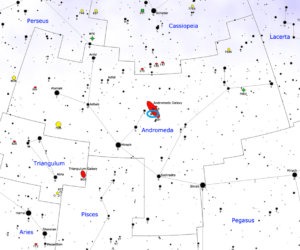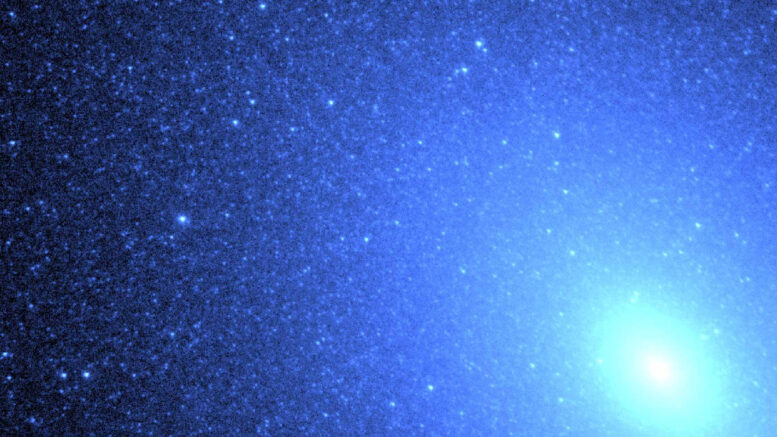Messier 32, abbreviated as M32, also known as Le Gentil, is a dwarf elliptical galaxy located in Andromeda constellation. Messier 32 was named after Guillaume Le Gentil, the French astronomer who discovered it in 1749. Messier 32 is a prototype for a class of galaxies known as compact ellipticals. It is believed to have once been a spiral galaxy, but as a result of interaction with the much larger Andromeda, its spiral arms were ripped off by the tidal forces from M31 and its stars and globular clusters now reside in the larger galaxy’s halo.
| Description | |
| Visible From Pacific Northwest | August To December |
| Best Time To Observe | November |
| Minimum Size Of Viewing Device | Binoculars |
| Object Type | Dwarf Elyptical Galaxy |
| Designations | Messier 32, M32, Le Gentil, NGC 221, Arp 168, PGC 2555, UGC 452, LEDA 2555, BD+40 147, IRAS 00399+4035 |
| Right Ascension | 00h 42m 41.8s |
| Declination | +40°51’55” vv |
| Constellation | Andromeda |
| Apparent magnitude | 8.08 |
| Apparent dimensions | 8′.7 x 6′.5 |
| Object Radius | 3,275×2,500 light years |
| Distance From Earth | 2,490,000 light years |
History
Guillaume Le Gentil discovered the galaxy on October 29, 1749. He noted, “While observing the Andromeda Nebula with a fine 18-foot telescope … I saw another small nebula, about one minute in diameter which appeared to throw out two small rays; one to the right and the other to the left.“
Charles Messier first observed the galaxy in 1757 and catalogued it on August 3, 1764, also thinking that it was a nebula.
William Herschel observed M32 in 1785 and described it as a “pretty large round nebula, much condensed in the middle, and south following the great one.“
John Herschel catalogued M32 as h 51 in 1828, observing that it is a “companion of the great nebula. Extremely bright; pretty large; there is a brighter middle to a star of 10 mag; 40″ diameter.“
Locating M32 In The Sky
Messier 32 is easy to find as it appears right next to the Andromeda Galaxy. It can be found by first locating the Great Square of Pegasus, formed by three stars that belong to Pegasus constellation (Scheat, Markab and Algenib) and Alpheratz, Alpha Andromedae. Alpheratz marks the northeastern corner of the square, the one facing Cassiopeia‘s famous W shape. With an apparent magnitude of 2.1, it is the brightest of the four stars. Going northeast of Alpheratz and looking under the W asterism, the three bright stars of Andromeda constellation are easy to spot: Delta Andromedae lies about 7 degrees from Alpheratz, Mirach (Beta Andromedae) is a further 8 degrees away, and Almach (Gamma Andromedae) is the third bright star along the same line and the closest one to Cassiopeia. The Andromeda Galaxy and Le Gentil can be found 8 degrees to the northwest of the middle star, Mirach. Le Gentil lies 22 arc minutes south of Andromeda‘s centre. It appears superimposed on Andromeda‘s outer spiral arm and is believed to be closer to us than that particular portion of the larger galaxy.

Viewing M32
Le Gentil can be seen in binoculars and appears like a hazy patch of light. In small telescopes, it looks like a diffuse ball of light with a bright core, surrounded by a small halo.
8-inch telescopes will reveal the galaxy’s oval shape, but even larger instruments will not show much detail because M32 is very small, especially when compared to M31.
Photographing M32
Messier 32 is actually quite a popular target for astrophotographers because of it being a satellite galaxy of Messier 31, the Andromeda Galaxy, which is a very popular target.
Therefore, when imaging M32, use make sure to follow guides for photographing Messier 31, the Andromeda Galaxy as capturing M31 will capture M32 with a wide enough image. There are many ways to capture M31 and M32, from using a CMOS and auto guiding scope to an unmodified DSLR and tracking. As such, there are a plethora of available options.
This includes using a DSLR for 2 second exposures, ISO 200 at f/2.0 for a photo that resembles M31 and M32 as a basic starting point to using a 6 inch telescope to get the entire area in the scope with 5.5 hours of exposure using a CMOS camera for a detailed view. It is definitely possible for everyone a specific skill level to photography M32.
Sources And Further Reading
Descriptions of all of Messier Objects can be found here
https://www.nasa.gov/feature/goddard/2017/messier-32
https://www.galactic-hunter.com/post/m31-the-andromeda-galaxy

Be the first to comment on "Messier 32"